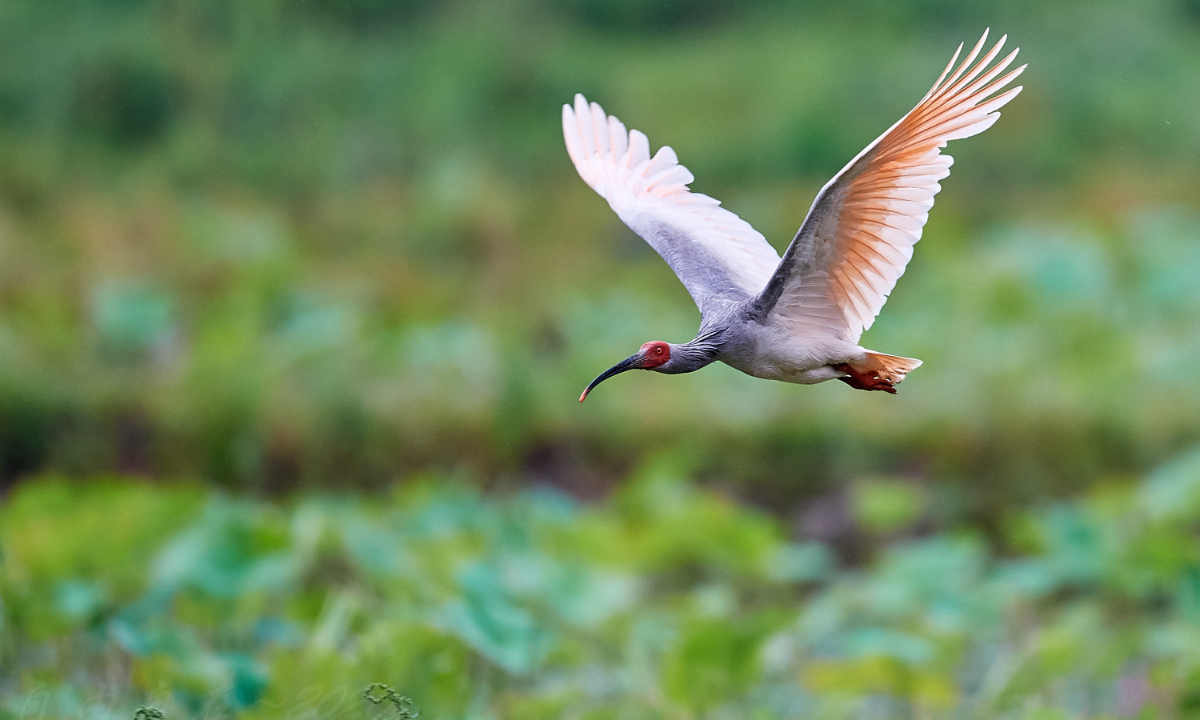Editor's Note:
With China as the country of presidency, the second phase of the 15th meeting of the Conference of the Parties to the UN Convention on Biological Diversity (COP15) is now beingheld in Montreal, Canada in December.
This series will show the various animals and plants in China that thrive as a result of the country's efforts in biodiversity conservation and building up sustainability.

Hanzhong, a city in Northwest China's Shaanxi Province, is home to the crested ibis, a rare type of bird native to East Asia that has existed for 60 million years but was once on the verge of extinction 40 years ago.
In 1981, seven wild crested ibis were found in Yangxian county in Hanzhong. The flock was then the only existing crested ibis in the world.
Due to the scarcity of the bird species, conservation efforts with the support of China's National Forestry and Grassland Administration were carried out in Hanzhong during the 1980s.
Over the past 41 years, older less-than-cost-effective approaches have been updated and new means such as artificial breeding technology, improved disease treatments and rewilding birds were added into conservation plans.
Yet the increase in the crested ibis's number from seven to 8,000 was mainly the result of the restoration of their habitat.
Xu Peng, a biodiversity researcher, told the Global Times that the improvement in the crested ibis's habitat was a "sustainable" conservation solution that not only provided a home for the birds, but also provided valuable experience that could be used elsewhere.
"When observing birds in their habitats, experts can identify more patterns and details related to the species, such experiences could become a mode that helps other biodiversity projects too," Xu noted.
Given that the crested ibis conservation project was noted by the IUCN as "an example of successful conservation of endangered species in the world," China's sustainability-oriented mindset has also been applied to protect the Petrocosmea qinlingensis plant.
Petrocosmea qinlingensis, known as the "stone butterfly" in Chinese, is a type of plant with little purple flowers that can only be found in Shaanxi Province.
When the wild plant population was rediscovered in 2013, there were fewer than 200, but through a "land plus research center" collaborative model, the number of the plants has increased to more than 10,000 with the help of artificial cultivation techniques.
The two successful examples have not only promoted the restoration of the ecological environment in the Qinling Mountains region, but also shed light on how cross-field sciences can contribute to China's biodiversity development.
With China as the country of presidency, the second phase of the 15th meeting of the Conference of the Parties to the UN Convention on Biological Diversity (COP15) is now beingheld in Montreal, Canada in December.
This series will show the various animals and plants in China that thrive as a result of the country's efforts in biodiversity conservation and building up sustainability.

A crested ibis Photo: VCG
Hanzhong, a city in Northwest China's Shaanxi Province, is home to the crested ibis, a rare type of bird native to East Asia that has existed for 60 million years but was once on the verge of extinction 40 years ago.
In 1981, seven wild crested ibis were found in Yangxian county in Hanzhong. The flock was then the only existing crested ibis in the world.
Due to the scarcity of the bird species, conservation efforts with the support of China's National Forestry and Grassland Administration were carried out in Hanzhong during the 1980s.
Over the past 41 years, older less-than-cost-effective approaches have been updated and new means such as artificial breeding technology, improved disease treatments and rewilding birds were added into conservation plans.
Yet the increase in the crested ibis's number from seven to 8,000 was mainly the result of the restoration of their habitat.
Xu Peng, a biodiversity researcher, told the Global Times that the improvement in the crested ibis's habitat was a "sustainable" conservation solution that not only provided a home for the birds, but also provided valuable experience that could be used elsewhere.
"When observing birds in their habitats, experts can identify more patterns and details related to the species, such experiences could become a mode that helps other biodiversity projects too," Xu noted.
Given that the crested ibis conservation project was noted by the IUCN as "an example of successful conservation of endangered species in the world," China's sustainability-oriented mindset has also been applied to protect the Petrocosmea qinlingensis plant.
Petrocosmea qinlingensis, known as the "stone butterfly" in Chinese, is a type of plant with little purple flowers that can only be found in Shaanxi Province.
When the wild plant population was rediscovered in 2013, there were fewer than 200, but through a "land plus research center" collaborative model, the number of the plants has increased to more than 10,000 with the help of artificial cultivation techniques.
The two successful examples have not only promoted the restoration of the ecological environment in the Qinling Mountains region, but also shed light on how cross-field sciences can contribute to China's biodiversity development.

